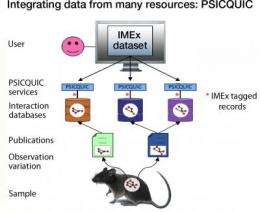Major networking opportunity: The IMEx Consortium brings interactomes to light

A new service makes it simple to find solid, experimental data about protein interactions. Writing in the journal Nature Methods, the IMEx consortium describes how a non-redundant experimental dataset will make it much easier for researchers to understand the complex set of protein interactions in cells.
Like people bustling around busy cities, the thousands of molecules inside our cells are constantly interacting with each other: turning each other on or off, working together, splitting up and networking. Understanding the countless ways in which they do so is a major challenge in biology, but it is fundamental to understanding life. Scientists at the European Molecular Biology Laboratory's European Bioinformatics Institute (EMBL-EBI) and colleagues in the International Molecular Exchange (IMEx) consortium are rising to the challenge by offering researchers a freely available set of experimental interaction data that can be queried from a single interface. Reporting in Nature Methods, IMEx partners describe the advantages of their service and invite others to join the effort.
To make it easier to create a picture of an organism's 'interactome' – the interactions between all of its molecules – IMEx partners have been working since 2004 to create a one-stop-shop for interaction data. A single standard for curating protein interaction data now makes it much simpler for scientists to identify which protein interactions are supported by the strongest evidence.
"There are over 100 interaction databases available, but none of them holds enough information to describe the interactome of any organism," explains Sandra Orchard of the EMBL-European Bioinformatics Institute (EMBL-EBI) in the UK. "In addition to the problem of repeated data entries in these databases, only around 1% of the 151 million binary pairs available are reliable data from published experimental work." The remaining data are theoretical, or the product of text mining; as such, they are far less dependable.
"We've now made it easier to find information about proteins that interact with a given molecule, and to compare new experimental results with publicly available, curated experimental data," says Gianni Cesareni of the University of Rome 'Tor Vergata' in Italy.
"IMEx web services now display curated, experimental data from several reputable resources so that a clearer picture of interactions between proteins can begin to emerge," says Henning Hermjakob, head of Proteomics Services at EMBL-EBI. "We are in effect optimising the return on public investment in interaction databases by co-ordinating global annotation efforts. We are certainly looking forward to having more curated data resources join the consortium."
Provided by European Molecular Biology Laboratory
















